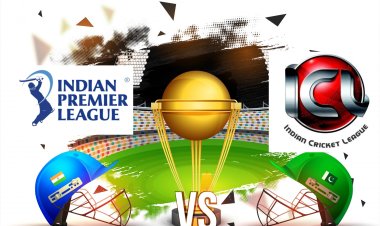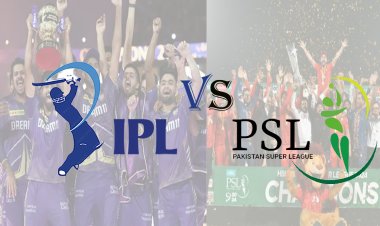WPL vs PSL: A Comparative Analysis of Cricket’s Emerging and Established Leagues
Explore the showdown between WPL and PSL—comparing prize money, player salaries, and the financial gap between these top T20 cricket leagues. Who’s winning off the pitch?

WPL vs. PSL 2025: A Tale of Two T20 Leagues – Prize Money, Player Earnings, and Financial Disparity
The world of T20 cricket is witnessing a fascinating evolution, with the Women’s Premier League (WPL) rapidly emerging as a financial powerhouse, even outpacing the more established Pakistan Super League (PSL) in several key metrics. Here’s a fact-driven comparison of these two leagues based on recent seasons.
Prize Money: WPL Outpaces PSL
Women’s Premier League (WPL):
-
2024 Winner: Royal Challengers Bangalore (INR 6 crore)
-
2024 Runner-up: Delhi Capitals (INR 3 crore)
-
2025 Winner: Mumbai Indians (INR 6 crore)
-
2025 Runner-up: Delhi Capitals (INR 3 crore)
-
Semifinalists: Each received INR 1 crore.
Pakistan Super League (PSL):
-
2024 Winner: Islamabad United (PKR 14 crore, approx. INR 4.13–4.31 crore)
-
2024 Runner-up: Multan Sultans (PKR 5.6 crore, approx. INR 1.65–1.72 crore)
-
Semifinalists: Each received PKR 2.5 crore (INR 0.77 crore).
The WPL, despite being only in its third season, offers higher prize money to both winners and runners-up than the PSL. This is a remarkable achievement for women’s cricket, highlighting the growing commercial appeal and investment in the women’s game in India.
Player Salaries: WPL Stars Earn More Than PSL Counterparts
-
WPL Top Earners: Players like Smriti Mandhana, Harmanpreet Kaur, Ellyse Perry, and Sophie Devine command salaries that are among the highest in women’s cricket.
-
Example: Jemimah Rodrigues (Delhi Capitals) was sold for INR 2.2 crore in WPL, which is over USD 268,000.
-
PSL Top Earners: Even the most expensive PSL players, such as Naseem Shah (Platinum category), earn up to USD 170,000, which is less than the top WPL salaries.
This means that the most expensive WPL players earn more than the most expensive PSL players, a trend that underscores the financial muscle behind women’s cricket in India.
Scale and Reach: WPL’s Global Appeal vs. PSL’s Challenges
League Performance and Achievements
-
WPL Champions:
-
2023: Mumbai Indians (defeated Delhi Capitals)
-
2024: Royal Challengers Bangalore (defeated Delhi Capitals)
-
2025: Mumbai Indians (defeated Delhi Capitals).
-
-
PSL Champions: In 2024, Islamabad United won their third title, defeating Multan Sultans.
Summary Table: Prize Money Comparison
| Tournament | Winner Prize (2024/25) | Runner-up Prize | Semifinalist Prize |
|---|---|---|---|
| WPL | INR 6 crore | INR 3 crore | INR 1 crore |
| PSL | INR 4.13–4.31 crore | INR 1.65–1.72 crore | INR 0.77 crore |
Key Takeaways
-
Financial Edge: The WPL, a women’s league, now offers higher prize money than the men’s PSL, highlighting the rapid growth and investment in women’s cricket in India.
-
Player Salaries: Top WPL players earn more than the most expensive PSL players, reflecting the lucrative opportunities for women cricketers.
-
League Growth: The WPL is quickly establishing itself as one of the most financially rewarding T20 leagues globally, even challenging established men’s leagues like the PSL.
WPL vs PSL Critical Perspective: Beyond the Numbers
Growth and Market Dynamics: Insights from WPL vs PSL Salary Differences
1. Commercial Strength and Investment
-
WPL’s Rapid Commercialization: The WPL, despite being a newer league focused on women’s cricket, has seen top players command salaries that surpass those of the most expensive PSL players. For example, Smriti Mandhana was retained for close to $400,000 in WPL 2025, while the highest-paid PSL player in 2025, David Warner, earned $300,000.
-
PSL’s Gradual Growth: PSL has steadily increased its top-tier salaries, with the Platinum category reaching $300,000 in 2025. However, even this new high is less than what top WPL players earn, signaling that WPL’s financial backing and commercial appeal are growing at a faster rate.
2. Attraction of Global Talent
-
WPL’s Appeal: The WPL’s high salaries and auction system have attracted top international women’s cricketers, making it a magnet for global talent. This is evidenced by the presence of elite overseas players like Ellyse Perry, Sophie Devine, and Ashleigh Gardner, who command significant fees.
-
PSL’s Challenges: While PSL has also managed to attract big names (like David Warner), it often has to compete with other leagues for global stars. The league’s draft system and lower maximum salaries can limit its ability to consistently attract the most sought-after international players.
3. Market Positioning and League Prestige
-
WPL’s Market Positioning: The WPL is positioning itself as the world’s premier women’s T20 league, with salaries that rival or exceed those in established men’s leagues outside the IPL. This reflects both strong sponsorship, media rights deals, and the financial muscle of the BCCI.
-
PSL’s Role: PSL remains a significant regional league in South Asia, but its salary structure and commercial deals are not yet at the level of the IPL or WPL. Its growth is steady, but it faces challenges in competing with Indian leagues for both viewership and talent.
4. Implications for Player Development and Retention
-
WPL’s Impact on Women’s Cricket: The high salaries in WPL are transformative for women’s cricket, providing financial security and professional opportunities that were previously unavailable. This is likely to accelerate the development of women’s cricket globally.
-
PSL’s Impact on Local Talent: PSL’s salary increases benefit local Pakistani players, helping to retain and develop domestic talent. However, the gap between what top international and local players earn remains, though it is narrowing.
Summary Table: Salary Comparison
| League | Top Player Salary (2025) | Notable Features |
|---|---|---|
| WPL | ~$400,000 (Smriti Mandhana) | Auction system, attracts top global women’s talent |
| PSL | $300,000 (David Warner) | Draft system, highest salary in PSL history |
Key Insights
-
WPL’s growth is being fueled by unprecedented commercial investment, leading to higher salaries and greater prestige for women’s cricket.
-
PSL is evolving and increasing its top salaries, but still lags behind WPL in financial clout and global appeal.
-
The salary differences highlight how women’s cricket in India is rapidly catching up to and even surpassing the financial rewards available in some men’s leagues, reshaping perceptions of women’s sports globally.
Conclusion
The comparison between WPL and PSL reveals a shifting landscape in cricket. The WPL’s financial rewards and player salaries now surpass those of the PSL, marking a significant milestone for women’s cricket and underlining India’s economic dominance in the sport.
While the PSL has a longer history, the WPL’s financial power and rapid growth make it a formidable competitor. The fact that WPL players earn more than some of PSL’s top stars underscores the changing landscape of cricket economics.
As women’s cricket gains more traction, the WPL could soon rival even the IPL in terms of commercial success, while the PSL continues to be a vital platform for men’s cricket in Pakistan.

 Editor
Editor 



























